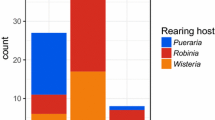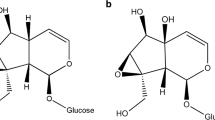Abstract
Exotic plants often displace native plants and thus alter the availability of native hostplants for specialist herbivorous insects. The submersed aquatic weevil Euhrychiopsis lecontei Dietz is endemic to North America, but there are now source populations on the exotic Eurasian watermilfoil (Myriophyllum spicatum L.) as well as on the weevil's ancestral host, northern watermilfoil (Myriophyllum sibiricum Komarov). This provides an opportunity to examine a host range expansion in progress. To further define the host range of the weevil and to determine how population source and rearing plant influence host plant preference and performance, we conducted a series of preference and rearing experiments with weevils from two source populations reared on northern milfoil, on Eurasian milfoil, switched late in larval development from northern to Eurasian milfoil, and vice versa. We also included two rearing treatments with milfoils on which the weevil has not been documented: the native M. verticillatum L. and the exotic M. aquaticum Verd. Preference by weevils in the switched rearing treatments was similar to preferences exhibited by weevils reared solely on the second (later) milfoil species and an increase in preference for Eurasian milfoil was induced by adult exposure to Eurasian milfoil for 2 weeks. In contrast, sizes and development times of weevils in the switched rearing treatments were similar to sizes and development times exhibited by weevils reared solely on the first (early) milfoil species. These results indicate that preference by the milfoil weevil is determined late in larval development or later and Hopkins' host selection principle is not supported. However, size and development time were most affected by hostplant quality during larval development when larvae must acquire the resources needed for pupation. Oviposition preference in the milfoil weevil was a population attribute, not a fixed individual attribute and there was no significant variation in preference among individuals reared on northern milfoil, but significant variation in preference was detected among weevils reared on Eurasian milfoil. Weevils oviposited on all four milfoil species and completed development on three of them, but did not develop beyond the larval stage on M. aquaticum. Weevils reared on Eurasian milfoil developed faster and reached larger adult sizes than weevils in any other rearing treatment. The smallest sizes and longest development times were for weevils reared on the natives, northern milfoil and M. verticillatum. The milfoil weevil oviposits on an array of milfoil species and is unable to distinguish an unsuitable host (M. aquaticum) within this genus. The influence of rearing plant and adult exposure to Eurasian milfoil on hostplant preference suggests that host range expansion to novel congeners may occur more rapidly than predicted by models which assume that genetic variation is required. Significant variation among individuals in hostplant preference suggests the potential for a host shift to a plant for which E. lecontei appears pre-adapted.
Similar content being viewed by others
Author information
Authors and Affiliations
Additional information
Electronic Publication
Rights and permissions
About this article
Cite this article
Solarz, S., Newman, R. Variation in hostplant preference and performance by the milfoil weevil, Euhrychiopsis lecontei Dietz, exposed to native and exotic watermilfoils. Oecologia 126, 66–75 (2001). https://doi.org/10.1007/s004420000484
Received:
Accepted:
Published:
Issue Date:
DOI: https://doi.org/10.1007/s004420000484




